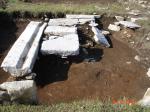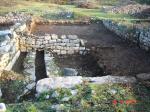Summary (English)
In the period from October to November, excavation was carried out on the site of Roman town Doclea in Podgorica.The site was situated on the eastern side of the forum where presumably two main streets were crossed each other. This site was marked with No. IX on the map made by Italian archaeologist Stikotti in 1913. Some of this area was investigated in excavations that took place in 2005, which were suddenly stopped. The excavation showed that building IX was built on the remains of an older building of which segments of the foundations were preserved in segments, at a relative depth of 120 cm, from the average height of visible walls. We cannot talk about the dimensions of the older building but it is obvious that its foundations were made of broken limestone. The demolition of the older building occurred at the end of the 1st Century AD which was confirmed by coins. Building IX can be perceived well, although it hasn’t been fully investigated yet. The structure covers a space of over than 2000 m2. There was atrium in the central part with probable dimensions of 25 × 25 m. From the western and southern side of the atrium there was a line of several insulae and a wide portico. There were three wide entrances from the main street (width of 220-250 cm) into the atrium space. One could enter through one entrance from the western side while the northern and eastern sides were still not defined. The excavation of room 3/IX gives us the most data about the intensive life in building IX. In this room, occupation took place in at least four stages that can be traced on the base of construction works. Unfortunately, it is still difficult to talk about the chronology of these stages. The coins on the floor of this room testify that occupation took place at the end of the second and during the third century. The pit found in this room has significant importance, because it may represent hiding place where a scared craftsman put his iron ax that he used for stone treatment. Beside that tool, he put several coins of which two were made of silver. On the face of one coin is represented woman with the inscription IVLIA MAESA AVG (218-222).
Director
- Dragan Radović - Public Institution Museums And Galleries, Podgorica
Team
- Ivana Medenica - Public Institution Museums And Galleries, Podgorica
- Nemanja Čavlović - Public Institution Museums And Galleries, Podgorica
- Magdalena Radunović - Public Institution Museums And Galleries, Podgorica
- Živko Radović - Public Institution Museums And Galleries, Podgorica
- Tanja Mijović - Centra za arheološka istraživanja Crne Gore
- Mile Baković
Research Body
- Public Institution Museums And Galleries, Podgorica
Funding Body
- Council of Podgorica






![Download [PDF]](/excavation/skins/fasti/images/results/download_sml.png)

